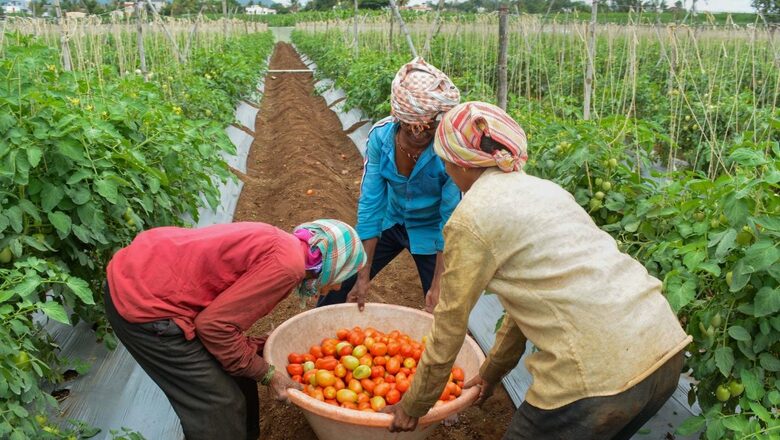
views
Policymaking in the agriculture space is rife with several myths, misconceptions, and assumptions. Unlike other spaces where lobbyists ensure that their current practices are part of policy thinking, agriculture is dominated by “bad” actors; these include research organisations and non-profits that are out of touch with reality, yet dictate policy. This is why antiquated models continue to dominate policymaking and thinking.
Institutional knowledge is a challenge to learning or building something new. Old mental models are like stereotypes; they force us to retrofit new information into old models. The challenge is that over a period, if these models are not updated or these assumptions are not questioned from a public policy point, then it creates more challenges than it solves. Trying to fit economic roadmaps followed by other countries decades ago to a populous country like India is one such thinking. A vast number of our models for developing policy still believe that the way to a developed economy is to move people out of agriculture, into manufacturing and services.
The Lewis Model for structural development, developed by economist W Arthur Lewis in the mid-1950s, remains the underlying assumption for this policy-making model. Lewis, a West-Indian economist, sharpened these models for England and believed this could be adopted by any developing country. He won a Nobel Prize for it, and the rest of the world continues to follow this model. The model used pre-war data from England to build a model for an economy of around 50 million people; its current population is around 67 million.
70 years or more old model of the economic system is not relevant in a world where automation has changed manufacturing employment and artificial intelligence (AI) is changing the services sector at an exponential daily pace. It surely cannot be used to frame policies that call for moving 400-odd million Indian farmers out of agriculture into manufacturing and services.
The Lewis model states that the early stages of a country’s development will be employed by the agricultural sector for subsistence. The agri-labor is typically underemployed with marginal productivity declining with time. As manufacturing and services rise, agriculture becomes a smaller part of the national revenue, and the manufacturing/services share rises.
The GDP shift from agriculture to other sectors also leads to previously underemployed agricultural labour in other sectors. This creates higher wages and is a sign of economic growth. Its biggest assumption is that as labour moves away from agriculture, those that remain have access to larger landholdings with which they can afford to industrialise and produce at larger scales.
Let’s pause and understand whether this is happening in India. Our manufacturing sector has grown but landholding has decreased instead of increasing because of population growth and fragmented landholdings as families grow and divide. Typically, in a farmer’s family, the males move out to the city leaving children, wives, parents and siblings behind. The only reason they survive the uncertainty of farming is because of the assured income of the few from urban centres.
If the Lewis model worked as it was supposed to, we would not see such a large population continuing to survive in rural areas. After all, manufacturing and services have grown enormously, accounting for more than 80 per cent of gross value added to the economy, and they employ 56 per cent of the population.
A NITI Aayog paper from 2022 highlights four structural paths that farmers could find themselves on: the Farmer Developing Path, the Lewis Path, the Lewis Trap, and the Farmer Excluding Path. Dorin Et al. first identified these paths using the Labour Income Ratio (LIR) – the ratio between agriculture’s share of value in the total value added to an economy and the share of farmers in the total labour employed – which measures a region’s reliance on agriculture in relation to its economy and workforce.
Changes in LIR over time can be used heuristically to place the farmers of a region in one of the four structural paths. If a region’s LIR is high and increasing over time, it is likely to be on the Lewis Path; if a region’s LIR is low and decreasing over time, it is likely to be on the Farmer Excluding Path; if a region’s LIR is high but decreasing over time, it is likely to be on the Lewis Trap; finally, if a region’s LIR remains stable over time then it is likely to be on the Farmer Developing Path. The NITI Aayog paper used LIRs for each Indian state to assign them to their respective path.
The Lewis Path is the structural path that farmers would find themselves in if Lewis’ predictions for the agricultural sector play out as they should. In the Lewis Path, the total number of farmers decreases, leaving the remaining farmers with larger landholdings with which they can produce more as per the NITI Aayog paper written in 2022.
The share of farmers in the workforce decreases; this raises agricultural productivity at a pace that is faster than overall agricultural output. While each farmer is producing more, collectively they are still farming the same amount of land, so the rate of increase in agricultural output isn’t as high and the prices for agricultural output remain stable. Here, LIR tends to be 1 because there are fewer farmers as a share of the total workforce, while agricultural output as a share of the total value added to the economy does not change very much.
In the Farmer Developing Path, the share of the value of agriculture grows larger without much change in the share of the value of the other sectors because of the relatively high growth in demand for agricultural products. On this path, agricultural workers see rates of increase in wages that are higher than in other sectors of the economy. The amount of labour employed in the agricultural sector increases.
As wages in the agricultural sector increase, workers move back to this sector. However, because there is not enough land available for everyone who wants to farm their own land, the number of people entering this sector does not increase at a faster rate than the demand for agricultural products and the value that agriculture is adding to the economy. The LIR tends towards 1 in the Farmer Developing Path.
The Lewis Trap is almost the exact opposite of the Lewis Path. The agricultural workforce increases without a proportional increase in the amount of land available for cultivation. Labour productivity in agriculture grows at a slower rate than the average labour productivity, which leads to a divergence in agricultural and non-agricultural wages.
In the Farmer Excluding Path, the number of farmers decreases while the incomes between the agricultural and non-agricultural sectors diverge. Farmers are fewer, and they are relatively poorer than workers in other sectors.
The NITI Aayog paper presented data showing that from at least 1993, all but three of the Indian states were on the negative structural paths of the Lewis Trap or Farmer Excluding. As a whole, the country was on the Lewis Trap path since at least 1993; in 2010, however, the country entered the Farmer Excluding path. The agricultural workforce was not falling, it was increasing. The paper says this could be a result of the Covid pandemic which saw massive levels of migration of urban workers back to their rural homes, this shift could be temporary in nature. Although the productivity of land has increased, the falling sizes of landholdings are ensuring that India’s agricultural labour productivity is growing slower than its non-agricultural labour productivity. This is the opposite of what was to happen according to Lewis’ model of structural transformation.
The Indian agricultural sector employs 44 per cent of the labour force in the country while only contributing 20 per cent to the GDP. According to the NITI Aayog paper, ensuring that the labour force employed by the agricultural sector falls to approach its contribution to the GDP would go a long way in bridging the income gap between the agricultural sector and the non-agricultural sector. But will the manufacturing and service sectors be able to absorb this labour?
The widely accepted path of economic development through the Lewis model occurs through the movement of labour from agriculture to manufacturing and later, the service sector. As of 2021, the manufacturing sector employed 25 per cent of the country’s workforce. This is around 120 million people, which is a sizable chunk of the workforce, but manufacturing sector employment is showing a worrying trend of manufacturing not being able to absorb as many people. This is also from a NITI Aayog paper.
A study from 2014 shows that the average labour intensity in the organised manufacturing sector was falling from the early 1980s, and has continued into the 2000s. At the start of the 1980s, the number of workers per real fixed capital in the labour-intensive manufacturing subsectors was more than five. This means that there were more than five workers for every unit of capital being employed in these sectors. By 2008, this same value had fallen to less than one. The other less labour-intensive sectors had falling levels of labour intensity as well. Between 1980 and 2010, the manufacturing sector’s labour intensity fell from an average of 1.45 to 0.33. This fall in labour intensity is a result of trade reforms that lead to a decrease in the prices of machinery relative to the price of labour, and this leads to manufacturers increasingly substituting labour for machinery–automation. From this, we know that investments in the manufacturing sector do not produce jobs the way they used to. Between 2011 and 2021, employment in the sector barely grew by 2 per cent. Considering that mechanization is becoming more effective and less expensive with time, it is unlikely that this trend will turn around in the foreseeable future.
The Indian service sector employs more people and contributes more value to the GDP than the manufacturing sector. As of 2020, it employed 30.8 per cent of the total workforce which amounted to almost 158 million people. The average YoY rate of increase between 2011 and 2019 was nearly 0.55 per cent. India’s service sector is unique compared with major powers. The service sectors in many countries employ people at a similar rate as the gross value added by their respective service sectors to their GDP. In the US, the share of services to GVA was 77 per cent and 81 per cent in 2007 and 2017, respectively, and the service sector employment was at 78 per cent and 79 per cent in 2007 and 2017, respectively. The German service sector’s GVA for 2007 and 2017 was 69 per cent and 68 per cent while the sector itself employed 68 per cent and 72 per cent of the population for the same two years. The trend is similar in many other countries.
For India, on the other hand, services’ GVA was 48 per cent and 54 per cent in 2007 and 2017, respectively, but it employed only 26 per cent and 34 per cent of the population, respectively. This feature of the service sector in India results in less labour being absorbed into the service sector than would be otherwise. With the development of AI technologies, it is reasonable to expect that the number of people absorbed by the service sector for each share of the value it adds to the economy would plummet further.
As the world’s most populous nation, India will have to move more workers out of agriculture than other countries on a similar path. Making matters worse is that service industries in India tend to absorb less labour than expected; it’s unrealistic to expect manufacturing to absorb more workers. Manufacturing in India has been seeing reductions in its levels of labour intensity for thirty years now, so it is not likely this trend will change to allow for greater movement of labour into manufacturing. Hence, India must think beyond the Lewis model of a developed country and think about retaining its agricultural labour in agriculture.
We need to start looking at a public policy that does not displace agricultural workers and not look at small farms as a problem but looks at models that make them more productive and sustainable, use less industrial inputs, and provide higher income. Economists need to stop suggesting large farms as a panacea to the agricultural labour problem. NGOs and organisations working to change rural poverty should look at labour-intensive rural areas models. Cities need not be the only drivers of India’s economic engine; distributed models of production in rural areas can also be a growth model for Bharat. We need to start asking questions that are more in line with our own demographic, economic, and geographical realities instead of trying to become another China or Europe when neither of them is possible. Let’s start solving for Bharat, instead of cutting and pasting our models and assumptions from the rest of the world to apply to India.
We should start thinking and doing for Bharat instead of building an Indian version of what the Western world considers as developed.
K Yatish Rajawat and Ravi Kambhampati are researchers at the Centre for Innovation in Public Policy, a New Delhi-based think and do tank. Views expressed in the above piece are personal and solely that of the author. They do not necessarily reflect News18’s views.




















Comments
0 comment